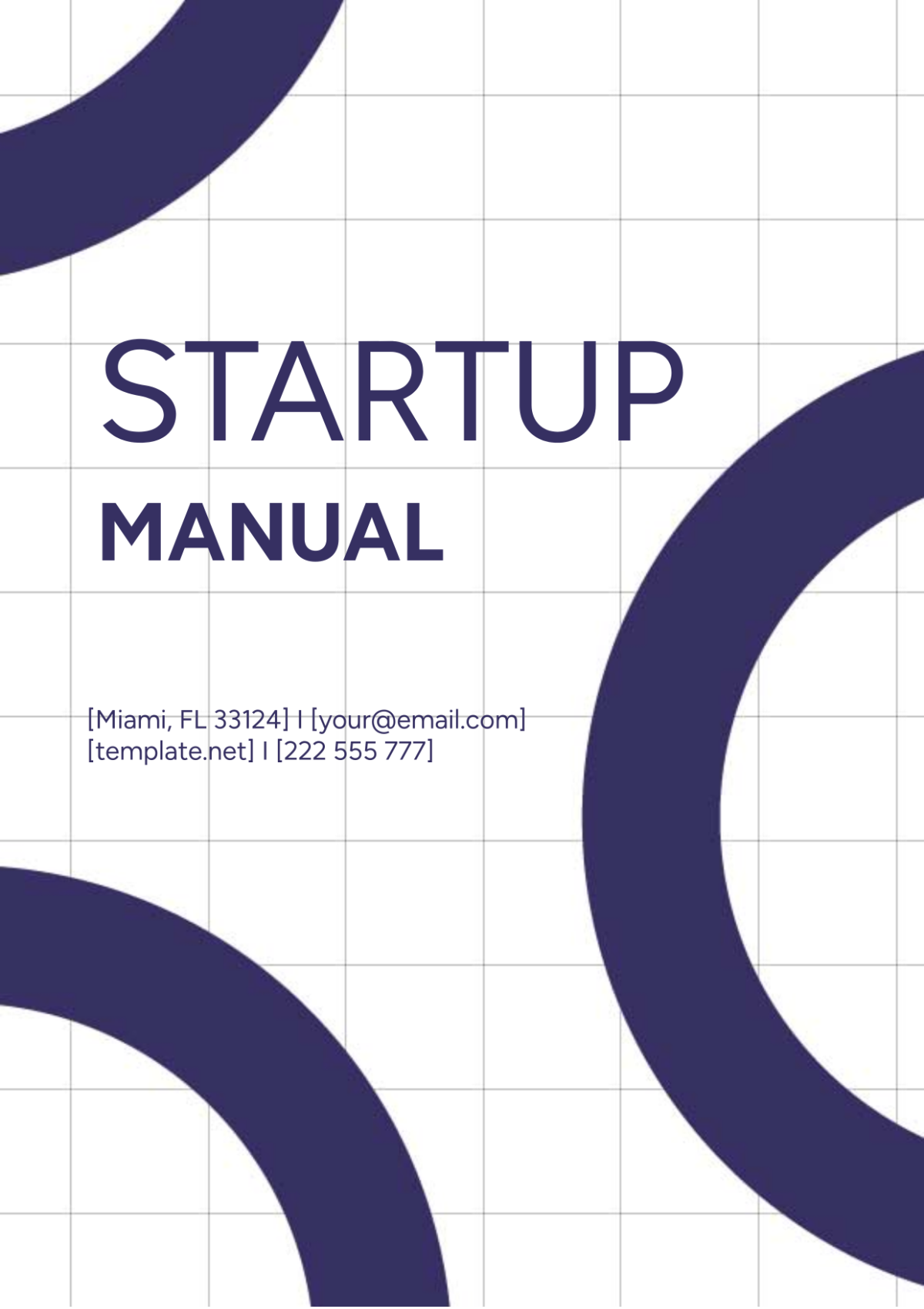STARTUP MANUAL
NAME: | COMPANY: | DEPARTMENT: | DATE: |
|---|
[YOUR NAME] | [YOUR COMPANY NAME] | [YOUR DEPARTMENT] | [DATE] |
I. INTRODUCTION
Welcome to the STARTUP MANUAL for [YOUR COMPANY NAME]. This manual is designed to provide comprehensive guidance for navigating the startup journey, from inception to growth. As a startup, it's essential to have a clear understanding of key processes, strategies, and best practices to ensure success in the competitive business landscape.
In this manual, you will find valuable insights and actionable steps to help you establish and scale your startup effectively. Whether you're a founder, entrepreneur, or team member, this manual serves as a roadmap for achieving your startup goals and objectives.
II. ESTABLISHING YOUR STARTUP
A. Vision and Mission
Defining Your Vision: Clarify the purpose and long-term vision of your startup. What problem are you solving, and what impact do you aim to make in the market?
Crafting Your Mission Statement: Develop a concise mission statement that communicates your startup's core values, goals, and commitment to serving customers.
B. Market Research and Analysis
Identifying Your Target Market: Conduct thorough market research to identify your target audience, understand their needs, preferences, and behaviors.
Analyzing Competitors: Analyze competitors to identify market gaps, strengths, and weaknesses. Use this information to differentiate your startup and develop a competitive advantage.
III. BUSINESS PLANNING AND STRATEGY
A. Business Model Canvas
Value Proposition: Define the unique value your startup offers to customers and how it solves their pain points or fulfills their needs.
Revenue Streams: Identify potential revenue streams and pricing strategies to monetize your products or services effectively.
B. Strategic Planning
Setting Objectives and Goals: Establish SMART (Specific, Measurable, Achievable, Relevant, Time-bound) goals and objectives to guide your startup's growth and development.
SWOT Analysis: Conduct a SWOT analysis to assess your startup's strengths, weaknesses, opportunities, and threats. Use insights gained to inform strategic decision-making.
IV. BUILDING YOUR TEAM
A. Recruiting and Hiring
Defining Roles and Responsibilities: Clearly define roles and responsibilities within your startup to ensure alignment and accountability.
Recruitment Strategies: Develop effective recruitment strategies to attract top talent, including leveraging online platforms, networking, and employee referrals.
B. Onboarding and Training
Onboarding Process: Develop an onboarding process to welcome new hires and introduce them to your startup's culture, values, and expectations.
Training and Development: Provide ongoing training and development opportunities to empower employees, enhance skills, and foster professional growth.
V. PRODUCT DEVELOPMENT AND LAUNCH
A. Product Development Lifecycle
Ideation and Conceptualization: Generate and evaluate ideas for new products or features, considering market demand, feasibility, and strategic fit.
Prototype and Testing: Develop prototypes and conduct user testing to gather feedback, iterate, and refine your product before launch.
B. Launch Strategy
Go-to-Market Strategy: Develop a comprehensive go-to-market strategy, including product positioning, pricing, distribution channels, and marketing tactics.
Launch Execution: Execute your launch plan effectively, leveraging various marketing channels, PR efforts, and partnerships to generate buzz and drive adoption.
VI. SALES AND MARKETING
A. Sales Strategies
Customer Acquisition: Develop strategies to acquire new customers, including prospecting, lead generation, and sales outreach efforts.
Sales Process Optimization: Streamline your sales process, leverage technology, and implement sales enablement tools to improve efficiency and effectiveness.
B. Marketing Campaigns
Targeted Marketing: Create targeted marketing campaigns to reach your ideal customers, leveraging digital marketing channels, content marketing, and social media advertising.
Brand Building: Build and strengthen your brand identity through consistent messaging, visual branding, and storytelling to differentiate your startup in the market.
VII. OPERATIONS AND LOGISTICS
A. Operational Processes
Supply Chain Management: Develop efficient supply chain processes to manage inventory, procurement, and logistics effectively.
Quality Control: Implement quality control measures to ensure product/service consistency and customer satisfaction.
B. Operational Efficiency
Process Optimization: Continuously optimize operational processes to improve efficiency, reduce costs, and enhance productivity.
Risk Management: Identify and mitigate operational risks, such as supply chain disruptions, regulatory compliance, and cybersecurity threats.
VIII. FINANCIAL MANAGEMENT
A. Budgeting and Forecasting
Financial Planning: Develop a comprehensive budget and financial forecast to manage cash flow, allocate resources, and track financial performance.
Expense Management: Implement expense management strategies to control costs, minimize waste, and maximize profitability.
B. Funding and Investment
Capital Raising: Explore various funding options, including bootstrapping, venture capital, angel investors, and crowdfunding, to secure financing for your startup's growth.
Investment Strategies: Develop investment strategies to allocate funds strategically, support growth initiatives, and generate returns for stakeholders.
IX. CUSTOMER SERVICE AND SUPPORT
A. Customer Experience
Customer-Centric Approach: Adopt a customer-centric approach to prioritize customer satisfaction, retention, and loyalty.
Feedback and Resolution: Solicit customer feedback, address inquiries promptly, and resolve issues effectively to enhance the overall customer experience.
B. Support Infrastructure
Support Channels: Establish support channels, such as help desks, ticketing systems, and live chat, to provide timely assistance and support to customers.
Training and Empowerment: Train support staff to handle customer inquiries professionally, empower them with resources and knowledge, and promote a positive customer service culture.
X. GROWTH STRATEGIES AND SCALABILITY
A. Expansion Plans
Market Expansion: Identify opportunities for market expansion, including geographic expansion, product diversification, and target audience expansion.
Strategic Partnerships: Form strategic partnerships and collaborations with other companies, organizations, or industry stakeholders to fuel growth and scale operations.
B. Scalability
Scalable Processes: Design scalable processes, systems, and infrastructure to accommodate growth without sacrificing quality or efficiency.
Organizational Agility: Foster organizational agility and adaptability to respond to market changes, emerging trends, and evolving customer needs effectively.
XI.CONCLUSION
Congratulations on reaching the end of the STARTUP MANUAL for [YOUR COMPANY NAME]! By following the guidelines and strategies outlined in this manual, you are well-equipped to navigate the challenges and opportunities of the startup journey.
Remember, building a successful startup requires dedication, perseverance, and continuous learning. Stay agile, be open to feedback, and embrace innovation as you work towards achieving your startup goals.
Thank you for your commitment to excellence and for choosing to embark on this entrepreneurial journey with [YOUR COMPANY NAME]. We wish you continued success and prosperity in all your endeavors.
Manual Templates @ Template.net






























